|
Mercedes SL-class (R230)
Debut: 2001
Maker: Mercedes-Benz
Predecessor: SL (R129)
|
|
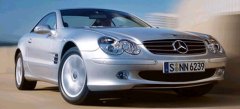 The
market segment for luxurious roadster/coupe is small but profit margin
is unusually high. For decades, it has been dominated by Mercedes SL,
which
was never seriously threatened by challengers such as Jaguar XJS, BMW
8-series,
Cadillac Allante and lately, Jaguar XK8 and Lexus SC430. The outgoing
SL
was so dominating that it lived for 12 years without major makeover,
during
that period some 200,000 cars were sold worldwide. It is amazing that
many
car journalists still regard the 12-year-old SL better than the
4-year-old
Jaguar XK8, its closest challenger to date. The
market segment for luxurious roadster/coupe is small but profit margin
is unusually high. For decades, it has been dominated by Mercedes SL,
which
was never seriously threatened by challengers such as Jaguar XJS, BMW
8-series,
Cadillac Allante and lately, Jaguar XK8 and Lexus SC430. The outgoing
SL
was so dominating that it lived for 12 years without major makeover,
during
that period some 200,000 cars were sold worldwide. It is amazing that
many
car journalists still regard the 12-year-old SL better than the
4-year-old
Jaguar XK8, its closest challenger to date.
Given
such background, undoubtedly, the new generation SL will enter a class
of its own. First of all, its sexy styling can blow the oppositions
away
in the first round of beauty contest. Its basic profile evolves from
the
1989 model, featuring similar proportion, trademark grilles and side
air
vents, but all surfaces and corners are polished to smoother and
sleeker.
Windscreen and rear window are more steeply raked so that it feels more
sporty. The preservation of low shoulder line - as opposed to recent
trend
- makes it look smarter and cleaner than others, especially facing
Lexus
SC430. British designer Steve Mattin has done a good job here.
Like
the old car, it looks long but not really so. Measuring at 4535mm, it
is
just 19mm longer than the Lexus and a massive 225mm shorter than Jaguar
XK8. Structurally, biggest change to the chassis is the adoption of
SLK-style
retractable hard top. Engineers are proud to announce that the electric
mechanism takes a world-record 16 seconds to fold the aluminium roof
into
the boot, some 9 seconds quicker than SLK and 4 sec faster than Lexus
SC430.
Moreover, the rear window is automatically detached from metal frames
and
stored independently to take advantage of its curvature in order to
save
luggage space. As a result, boot volume is a remarkable 265 litres when
the roof is down. Roof up, that increase to 290 litres.
One
of the weakness of the old SL was overweight. Therefore the new SL
employs
aluminium in bonnet, boot lid, front wings and doors, and magnesium
inner
door shells like its CL cousin. And we have already mentioned the
aluminium
retractable roof. Better structure and more usage of high-strength
steel
result in 20% increase of chassis rigidity. Despite of this, the new
SL500
tips the scale at 1770kg (or 1845kg according to EU calculating
method),
some 45kg lighter than the old 500. Aerodynamics is another area of
improvement
- drag coefficient becomes 0.29 and 0.34 for roof up and down
respectively.
The old car’s were 0.32 and 0.43.
While
the all-alloy, 3-valve-per-cylinder, 5-litre V8 and the mandatory
5-speed
automatic are unchanged, they take advantage of the lighter kerb weight
to deliver stronger performance - we are talking about 0-60 in 6.0
seconds
and a limited 155mph. If not enough, you can choose the AMG SL55 whose
supercharged V8 pumps out 476 horsepower. It should do 0-60 in a
supercar-rivaling
4.5 seconds. Nevertheless, as the beauty of SL is always relaxed
motoring,
I think 306 horsepower is perfectly adequate. The V8 is strong, creamy
smooth yet economical for its kind (thanks to automatic cylinder
cut-off
at light load). Who needs V12 or supercharger ?
I can’t
think of any roadsters or coupes more relaxing to drive. Its engine is
so refined, gearshift is so seamless, chassis is so free of NVH,
steering
is so free of kickback, ride is so compliant, so supple that you might
think you are driving a long-wheelbase S-class. Look at the spec. and
you’ll
know why: suspensions are made of aluminium to reduce unsprung weight;
the adoption of active body control (ABC) allows softer setup without
ruining
handling. The cabin also plays an important role in relaxed motoring -
sit on the comfortable and all-adjustable seats with massager and
cooling,
face the stylish, Alfa-like radical dashboard which is made of far
higher
quality than any post-1996 Mercedes, press a button and 16 seconds
later
you are enjoying fresh air and sunshine...
 But
attack the first corner and you’ll know this Mercedes is also a sports
car simultaneously. Whenever computer senses hard cornering (or you can
switch it manually as well), the active body control enters sports
mode,
firming up the hydraulic-aided springs at each suspension and limiting
body roll in cornering. For example, at certain speed when the old SL
rolls
7°, the new car is limited to just 2.5°. The changeover from
normal
to sport mode is fluent thus you won’t aware the transition point. But
attack the first corner and you’ll know this Mercedes is also a sports
car simultaneously. Whenever computer senses hard cornering (or you can
switch it manually as well), the active body control enters sports
mode,
firming up the hydraulic-aided springs at each suspension and limiting
body roll in cornering. For example, at certain speed when the old SL
rolls
7°, the new car is limited to just 2.5°. The changeover from
normal
to sport mode is fluent thus you won’t aware the transition point.
You
must also notice 3 other new features that sharpen the handling of SL:
1) the front suspensions has been changed from struts to 4-link to
improve
camber control, hence front-end grip and agility; 2) like C-class, it
employs
rack-and-pinion steering instead of the ancient recirculating-ball
design.
Accompany with a quick steering ratio which takes just 2.6 turns from
lock
to lock, the steering is now more precise and responsive; 3) the SL
introduces
the world’s first brake-by-wire system (SBC or Sensontronic Brake
Control)
which uses electronics to activate brakes rather than today’s hydraulic
linkage between pedal and brakes. By doing so, computer can apply
different
brake pressure to individual wheels, maximizing the performance of ESP
yaw control. Until now, ESP can just signal individual wheels to brake
more or less frequently but unable to alternate braking force. No
wonder
the new brakes feel so powerful.
There
are some foolish commentary saying the SL not a real driver’s car
because
of light steering and incapable of power-oversteer. Forget that. The SL
is not designed to take on Ferrari Maranello or Porsche 911. If it were
so, it would not have been so comfortable and enjoyable. However, if
you
let me choose between 911 Carrera and SL500 as my sole car, I think I
would
choose the latter. It is simply more desirable to own and to enjoy
everyday.
After all, the new SL’s mission is to continue its domination of the
luxurious
roadster/coupe market. It does that cleanly, and extend its advantage
further.
It sends Jaguar XK8/R to the second division, and relegates Lexus SC430
to the third division. Its leadership position is guaranteed until,
well,
the next generation SL come. |
| The
above report was last updated on 18 Oct
2001. All Rights Reserved. |
SL55 AMG
|
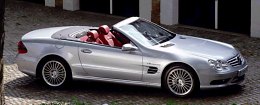 The
standard SL500 with its 306hp V8 is already quite quick - it can
accelerate from zero to sixty in 5.8 seconds. However, there are always
some customers wanting more performance - and plenty of them can afford
that. These are the AMG’s loyal customers. They know AMG is the last
word
for luxurious performance regardless of price. A Porsche or a BMW
M-power
were never considered. Therefore as early as the launch of new SL we
knew
a AMG version is just a matter of time. The
standard SL500 with its 306hp V8 is already quite quick - it can
accelerate from zero to sixty in 5.8 seconds. However, there are always
some customers wanting more performance - and plenty of them can afford
that. These are the AMG’s loyal customers. They know AMG is the last
word
for luxurious performance regardless of price. A Porsche or a BMW
M-power
were never considered. Therefore as early as the launch of new SL we
knew
a AMG version is just a matter of time.
What
surprise us is how serious AMG this time. Calling SL55 AMG, it would
have
been logical to assume it use the same 5.5-litre version V8 as the
existing
CL55, E55, S55 and CLK55 (and if you remember, the last generation
C55).
360 horsepower would have been fine for a top SL. However, AMG was not
content. It fitted a Japanese-made IHI supercharger into the V-valley
in
the same way as the smaller V6 of C32, running it at a maximum boost
pressure
of 0.8 bar. Use your calculator and you will see the engine equals to a
10-litre normally aspirated engine ! unbelievable ... if anyone apart
from
American love the concept of Muscle Cars, it must be AMG. Since its
first
300SE 6.3 - some thirty years ago - it has been producing modern muscle
cars.
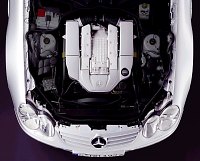 You
may be slightly disappointed by its 476 hp output, which cannot match a
Ferrari 550 V12 (same displacement but no charger). Think about this:
the
Mercedes mega V8 is somewhat bounded by its basic architecture of
single-cam
3-valve-per cylinder. Also, supercharged engines are not good at top
end
power. On the plus side, it is compact and lightweight for its class.
AMG
did a very good job in lifting its revability, which sees maximum power
occurs at 6,100rpm. However, the strength of the V8 - like most
supercharged
engines - lies on the torque curve. At just 1500rpm, it pumps out the
same
torque (369 lbft) as BMW M5 does at peak. At 2000rpm, it overtakes
McLaren
F1 at its best (479 lbft). From 2650rpm continuously to 4500rpm, it
generates
the maximum 516 lbft, more than any supercars ever achieved. Only
Bentley’s
6.75-litre V8 turbo can better it. You
may be slightly disappointed by its 476 hp output, which cannot match a
Ferrari 550 V12 (same displacement but no charger). Think about this:
the
Mercedes mega V8 is somewhat bounded by its basic architecture of
single-cam
3-valve-per cylinder. Also, supercharged engines are not good at top
end
power. On the plus side, it is compact and lightweight for its class.
AMG
did a very good job in lifting its revability, which sees maximum power
occurs at 6,100rpm. However, the strength of the V8 - like most
supercharged
engines - lies on the torque curve. At just 1500rpm, it pumps out the
same
torque (369 lbft) as BMW M5 does at peak. At 2000rpm, it overtakes
McLaren
F1 at its best (479 lbft). From 2650rpm continuously to 4500rpm, it
generates
the maximum 516 lbft, more than any supercars ever achieved. Only
Bentley’s
6.75-litre V8 turbo can better it.
How
fast the SL55 AMG can go ? German magazine Auto Motor und Sport
recently
tested it against Aston Vanquish, Ferrari 550M, Lambo Murcielago and
Porsche
GT2 at Italy’s Nardo test track. The result was an astonishing 202 mph,
just bettered by the Lamborghini.
 Let
me spend some more time on this subject. On the net there were some
people
suspecting Mercedes supplied AMS a car generating more power to get
better
result. They simply did not believe the "476hp-only" Mercedes can do
more
than 200mph. In my opinion, if we can believe a Ferrari F40 reached
196mph
out of 478hp, we must believe the Mercedes can do 202mph. Considering
the
F40 had a drag coefficient of 0.34 while the Mercedes is just 0.29 (the
best ever for supercars), if their frontal areas are the same, my
calculation
tells me the latter can top even 212mph ! Let
me spend some more time on this subject. On the net there were some
people
suspecting Mercedes supplied AMS a car generating more power to get
better
result. They simply did not believe the "476hp-only" Mercedes can do
more
than 200mph. In my opinion, if we can believe a Ferrari F40 reached
196mph
out of 478hp, we must believe the Mercedes can do 202mph. Considering
the
F40 had a drag coefficient of 0.34 while the Mercedes is just 0.29 (the
best ever for supercars), if their frontal areas are the same, my
calculation
tells me the latter can top even 212mph !
That’s
the theory. In reality, Mercedes’ engineers swore they saw 208mph
during
testing. So why not AMS match that ? because for over 200mph Nardo is
not
the best place to test top speed. Although the circular test track has
banked angle to cancel centrifugal force, it is still no replacement
for
a pure straight line. That’s why McLaren F1 chose Germany’s
Ehra-Leissen
test track to record its 240mph top speed.
Now
back to SL55 AMG itself. Excluding engine and performance, the
modifications
made were rather subtle. This is not a stripped-out performance car. It
retains all the creature comfort of the standard SL, including the
luxuriously-equipped
cabin and retractable roof. As a result, it tips the scale at 1880kg,
some
110kg heavier than SL500 because of the strengthened engine, brakes and
rear subframe (changed from aluminium to steel). Weight penalty in
addition
to the use of 5-speed automatic (now with button shift) result in a
less
impressive 0-60mph time of 4.4 second. Once on rolling, the heavyweight
supercar becomes more accelerative.
Mercedes
does not employ its new ceramic brake disc on the car, but using
360mm-diameter
disc with 8-piston caliper up front is effective enough to stop the
near
2-ton car. Also, it has the SBC brake-by-wire as the standard car.
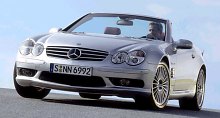 It
is amazing that the SL55 AMG does not need any suspensions and chassis
modifications to cope with its new found performance. The monocoque
still
feels rock solid at push. The retractable roof doesn’t leak at top
speed.
The Active Body Control suspensions result in stable and agile
cornering.
Apart from stronger acceleration force and more tyre noise, you won’t
notice
you are driving a 200mph supercar. It is so refined that, according to
AMS, at 200mph the driver can still search for the switch to activate
the
massager function of the seats ! before the SL55 AMG, no one could have
thought about a supercar so comfortable and easy to drive. Think about
how revolutionary Honda NSX was in 1990 against its rawer Ferrari and
Porsche
rivals and you will understand. Perhaps the AMG’s breakthrough is even
bigger than that. It
is amazing that the SL55 AMG does not need any suspensions and chassis
modifications to cope with its new found performance. The monocoque
still
feels rock solid at push. The retractable roof doesn’t leak at top
speed.
The Active Body Control suspensions result in stable and agile
cornering.
Apart from stronger acceleration force and more tyre noise, you won’t
notice
you are driving a 200mph supercar. It is so refined that, according to
AMS, at 200mph the driver can still search for the switch to activate
the
massager function of the seats ! before the SL55 AMG, no one could have
thought about a supercar so comfortable and easy to drive. Think about
how revolutionary Honda NSX was in 1990 against its rawer Ferrari and
Porsche
rivals and you will understand. Perhaps the AMG’s breakthrough is even
bigger than that.
Any
disadvantages ? while the standard SL is not the ultimate driver’s tool
for its class, the SL55 AMG is also not a real super sports car. There
is no two-edge sword here: for the benefit of refinement, its steering
and suspensions filter some road communication that supercars needed.
Weight
is another problem preventing it from being as agile and throttle
adjustable
as Ferrari 550 or Porsche 911 Turbo. It can be the King of Autobahn -
both
in straight line and high-speed bend, but to keen drivers the Maranello
is still the ultimate front-engined GT. |
| The
above report was last updated on 19 Jan
2002. All Rights Reserved. |
SL55 AMG now 500hp
|
The
suspect of understated power mentioned above has been finally confirmed
by Mercedes-Benz. Now the company re-rated it as 500 horsepower. The
previous
476hp was said as the lower end of the tolerance.
By
the way, Autocar magazine tested the car twice and failed to match the
performance figures recorded by AMS. The British magazine timed 0-60mph
in 4.7 seconds and 0-100mph in 10.3 seconds. Now another suspicion is
raised:
did Mercedes really give AMS a standard-tuned SL55 for testing? or a
car
specially tuned to deliver more power? |
| The
above report was last updated on 1 Nov 2002. All
Rights Reserved. |
SL65 AMG
|
 If
SLR McLaren is not as good as expected, why not buy a SL65 AMG at half
the price instead? that's a good question. The AMG-tuned 6.0-litre
twin-turbo
V12 has been used in CL65 AMG which I reported last September. Putting
it into the SL body is definitely a cleverer idea, as we know the SL
has
a better chassis than the saloon-derived CL. The twin-turbo V12
produces
virtually the same power as the supercharged V8 of SLR (612hp vs
626hp),
and considerably more torque (738 lbft vs 575 lbft). On the downside,
the
SL65 carries 330 kilograms more than the carbon-fiber-body SLR. If
SLR McLaren is not as good as expected, why not buy a SL65 AMG at half
the price instead? that's a good question. The AMG-tuned 6.0-litre
twin-turbo
V12 has been used in CL65 AMG which I reported last September. Putting
it into the SL body is definitely a cleverer idea, as we know the SL
has
a better chassis than the saloon-derived CL. The twin-turbo V12
produces
virtually the same power as the supercharged V8 of SLR (612hp vs
626hp),
and considerably more torque (738 lbft vs 575 lbft). On the downside,
the
SL65 carries 330 kilograms more than the carbon-fiber-body SLR.
Put
them against the clock, the SL65 takes just 4.1 seconds to sprint from
rest to 60mph, versus 3.8 seconds the SLR needs. The gap grows wider
when
arriving 124mph: SL65 takes 12.9 seconds, SLR takes 10.6 seconds. The
competition
stops when SL65 arrives its electronic regulated top speed of 155mph
while
SLR continues to cruise to somewhere around 206mph. Theoretically, the
SL65's sleeker shape (with a Cd 0.30 versus SLR's 0.374) enables a top
speed in excess of 220mph, but nobody would dare to try that - it would
be lucky if somebody can see that speed before airborne. The point is,
there is always a reason behind the McLaren's poor drag coefficient,
and
I guess you know why.
So,
instead of trying to compare SL65 AMG with SLR, we had better to
concentrate
on its own strength - smooth and relatively quiet V12, large and
luxurious
cockpit, refined ride and that retractable roof. Originally, Mercedes
wanted
to make SLR the most comfortable supercar, but that was not very
successful.
Now SL65 AMG could satisfy those who want supercar performance while
retaining
the luxury of a Mercedes-Benz. And, at the same price as Ferrari 575
Maranello,
it seems a bargain too. It can't compete with the Ferrari for handling
and feel, but its superior performance will steal many sales from
Maranello.
|
| The
above report was last updated on 23 Aug
2004. All Rights Reserved. |
SL facelift and SL63 AMG
|

|
Most cars are renewed after 6 and a
half years. To Mercedes SL, this is only the Part II of its long life.
|
Mercedes
SL has always been an enduring product line. Most cars nowadays last
for 6 or 7 years before they are replaced. Not so the SL. Six and a
half years old is only midway of its expected life cycle. However, even
this excellent car cannot afford to rest on its laurel. Since mid-2006
its limelight has been taken away by Jaguar XK. Although this is not
much of a surprise to the long-serving Mercedes, it still needs to
strike back with a mid-life facelift. The mission is clear: to bring
the SL back to the forefront of competition.
The facelift majors on 3 areas: styling, engine and steering. Outside,
the new SL returns to a wide and pronounced grille like its predecessor
(the 1989 SL), giving the Mercedes a more distinctive character. The
peanut headlights and bumpers are also reshaped to be more stylish.
Predictably, AMG models get even more aggressive and stylish bumpers
and wheels.
In the engine compartment, Mercedes added its 231 hp 3.0 V6 as the
entry-level model (dubbed SL280). Besides, SL350 has its 3.5-liter V6
enhanced to 316 horsepower and 265 lb-ft of torque. This is achieved by
using higher compression, lighter piston, lighter intake valves, faster
cam timing and switched to a higher-flow (but fixed length) intake
manifolds. This engine has been shown in the recent SLK facelift, but
in the larger engine compartment of SL, its exhaust is freer thus
results in 11 more horsepower at the top end. Interestingly, the new
3.5 V6 is actually more powerful than the 5.0 V8 serving SL500 a couple
of years back. Technological advancement helps reducing fuel
consumption and emission.
Concerning steering, the facelifted SL adopts a variable-ratio
speed-sensitive power steering like the recent SLK. This sharpens its
steering response in cornering without affecting cruising refinement.
SL63 AMG
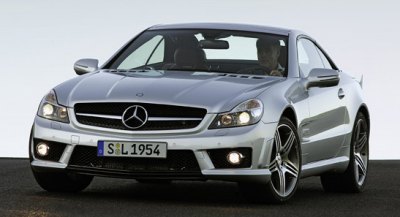
|
New "63" engine brings no actual
improvement to performance, but subjectively it is on a new level...
|
The
biggest
news to the facelift is the replacement of SL55 AMG with SL63 AMG.
Power increased from 500 hp to 525 hp, while torque reduced from 516
lb-ft to 465 lb-ft. As we have seen in E63, CLS63, CL63 and S63,
replacing the super-torquey 5.4-liter supercharged SOHC V8 with the
free-revving 6.2-liter DOHC V8 brings no actual improvement to
performance, but it gives a significantly more desirable driving
experience, no matter its aural quality or top-end eagerness. From
handling point of view, replacing the immense bottom-end torque with a
linear torque delivery results in easier control in corners, thus the
real-world performance of SL63 AMG is easier to exploit. Its power and
chassis work more in harmony. In contrast, the previous SL55 AMG could
be felt over-engined.
Another major modification of SL63 is the 7-speed MCT (Multi-Clutch
Technology) gearbox. Based on the 7G-Tronic automatic gearbox with
planetary gear sets, MCT has conventional hydraulic torque converter
replaced with an automated multi-plate clutch to enable faster
gearshift response, so it is a crossover between automatic and manual
gearbox. It offers 4 modes of operation – C (comfort) takes 200 ms to
shift gear, S (Sport) takes 160 ms, S+ (Sport+) takes 120 ms, while M
(Manual) takes 100 ms. The last one matches that of Ferrari 599 GTB !
The MCT gearbox combines the best of two worlds - seamless shift of
automatic transmission and responsive shift of manual transmission. Now
DSG has a strong rival. I hope Mercedes will adopt it on all other AMG
models in the future.
SL65 AMG
Changes to the range-topping SL65 AMG model is rather disappointing,
because it gets only the same cosmetic changes of the SL63. AMG did not
alter its 6.0-liter twin-turbo V12, because it is already powerful
enough, nor the 5-speed automatic transmission, because it is the only
gearbox in Mercedes' parts bin capable of withstanding the 738 lb-ft of
torque the V12 generated. In the view of environmental concern,
Mercedes and AMG might stop developing the V12 and replace it with
turbocharged V8 in the future. |
| The
above report was last updated on 9 Apr 2008. All
Rights Reserved. |
SL65 AMG Black
|
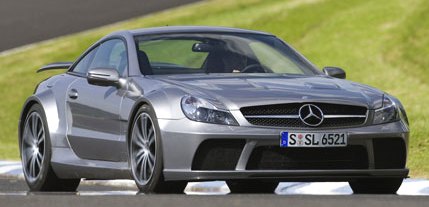
|
Mercedes' in-house division wants to
better McLaren, but who cares ?
|
Following
SLK Black and CLK Black, the exotic Black series expands to the
flagship SL. The existing 612-horsepower SL65 AMG is already one of the
fastest grand tourers in the world (0-60 mph in 4.1 seconds, 0-124 mph
in 12.9 seconds and a derestricted top speed of over 210 mph), but
compare with the Black version it is nothing. This car is 60 hp more
powerful yet 250 kg lighter. Its power-to-weight ratio is a good 24
percent higher than SL65 AMG, even higher than Lamborghini LP640. It
does 0-60 mph in 3.7 seconds, 0-124 mph (200km/h) in less than 10
seconds and 0-186 mph (300km/h) within 30 seconds. This matches the
mighty SLR 722 built by McLaren.
The objective of the SL65 AMG Black project is very simple: to take the
limelight from McLaren back to Stuttgart. The McLaren SLR project has
never been as successful as Mercedes hoped for. Its performance wasn't
good enough for its price (£340,000 for 722). Its cabin is
cramped by the standard of Mercedes. Its ride is stiffer than many
mid-engined supercars. But most important, its sales has been
disappointing - so far only 1577 SLRs have been sold. By the time its
production come to a stop next year, its accumulated sales will still
be less than half of the number originally planned (3500 units). That
is why Mercedes-AMG stopped working with McLaren and is now partnering
with HWA (the company which runs AMG's racing program) to design and
build its next generation supercar called "SLC".
However, before that happen, AMG thinks itself is capable to do
something. A Black series of SL65 AMG will come at the right time. Only
350 units will be made in less than 2 years before SLC arrived. Each of
them is priced at a relatively reasonable £214,000 or US$300,000.
It will offer the space and ride quality McLaren SLR couldn't hope for,
and performance matching the latter. Yes, dump the British and go it
alone !

|
Aggressive looks combines with 250 kg
weight reduction and 670 horsepower tune
|
Based
on the
production SL65, AMG modified the car thoroughly. First, the twin-turbo
6.0-liter V12 received a pair of larger turbochargers with 12 percent
higher flow and a 30 percent more powerful intercooler. Water cooling
to the engine has been enhanced, while new exhaust silencers return
lower back pressure. Maximum power is increased to 670 horsepower at
5400 rpm, while max torque remains unchanged at 738 lb-ft (1000Nm) from
2200 rpm continuously to 4200 rpm. This is because Mercedes' 5-speed
automatic is only capable of withstanding 1000 Nm.
Due to this tremendous torque, it cannot employ the excellent 7-speed
MCT gearbox that serves SL63 AMG. However, the shift pattern of the
5-speed auto has been revised to deliver more driver appeal. Apart from
the usual Comfort, Sport and Manual mode, AMG added a second Manual
mode (M2) whose shift time is 25 percent faster than M1. The gearbox
also facilitates throttle-blip on downshift to match rev thus shortens
shift time.
An important part of the performance upgrade is weight reduction.
Considerable weight is saved by ditching the retractable roof
mechanism, replaced by an aluminum roll cage (which also stiffens the
chassis) and a fixed carbon-fiber roof panel. All other parts of the
bodywork, except the standard aluminum doors, are also converted to
carbon-fiber composites. These include the bumpers, bonnet, fenders and
boot lid. Overall, the SL65 AMG Black tips the scale at 1795 kg (DIN),
some 250 kg lighter than the standard car.
Surprisingly, the diet did not stripe out the cabin. Most luxury
features and leather/alcantara trim remain. The most obvious weight
saving is the carbon-fiber bucket seats. Other changes include a
small-diameter flat-bottom steering wheel and some carbon-fiber decors
to enhance visual appeal.
Some weight is saved from the suspensions instead. Gone is the heavy
ABC active body control suspension, replaced by conventional springs
and dampers. However, like CLK63 AMG Black, the dampers here are
racing-style adjustable dampers. Compression rate, rebound rate, ride
height, camber and track width are all adjustable. Apparently, this car
has been designed with track days in mind. The rear axle now features a
limited-slip differential. The ESP stability control offers 3 levels of
intervention, including a complete off. The steering has faster ratio.
The brakes are uprated, of course, 391mm and 360mm ventilated steel
discs, 6-pot and 4-pot calipers front and rear respectively. They are
the largest brakes ever on an AMG model. The wheels and tires are
monster sizes, even larger than SLR's
As you can see, the Black version has much wider tracks than the
standard car, some 97mm wider up front and 85 wider at the rear thanks
to the race-car-like fenders. Countless of large air intakes and
outlets are opened for the benefits of cooling and aerodynamics. Note
that a new tail spoiler, normally recesses flush in the body, raises in
the air at above 75 mph to enhance downforce. This allows the car to
run stably at 199 mph. Mercedes did not cooperate with tire makers to
develop special tires for 200 mph+ run, so it has to set the electronic
regulation at 199 mph. In fact, the car has a potential of 220 mph if
derestricted.
 |
Disappointingly, It does not deliver
what it promised...
|
On the Road
One word summarizes it all: Disappointing. The SL65 Black should have
been a fast yet refined highway express. However, it does not deliver
what it promised.
Undoubtedly, it is very fast in straight line. Once its turbos get up
to mood, you will be difficult to beat it in any production Porsche.
Unfortunately, real world driving is not as simple as straight line
performance measurement. When the road gets curvy, you need to
decelerate and accelerate. Engine rev goes up and down in unpredictable
pattern. Here reveals its first problem: the large turbos have some old
fashioned turbo lag. Well, this problem alone may be bearable, but when
it combines with a slow reacting torque converter auto, the problem is
amplified. While the turbos get on and off during cornering, the auto
fails to follow the rev and always upshift or downshift at the wrong
moment. You can imagine how frustrating the experience is.
The handling is not especially sweet either. This low-riding chassis is
tuned for track, obviously. It achieves flat cornering in the expense
of ride, which is hard even by the standard of Ferrari and Porsche. On
track, its ESP stability control works overtime to tame the power. With
a set of narrow front tires (deliberately chosen), the car understeers
heavily in corners. When it exits corner, the earlier you apply
throttle, the more understeer dials in, thus force you to back off. To
drive it smoothly on track, you have to avoid overestimating its
chassis balance and always apply throttle with discipline. However, it
won’t bite you if you abuse the throttle pedal. In fact, the SL65 Black
is set up to deliver a safe handling.
But safe also means boring. On roads, the car feels huge and bulky. It
simply lacks the chassis balance and suspension composure to attack
twisty roads fluently. Its excessive width is a nightmare on mountain
roads. Its turning circle is so large that it will have problem going
through tight hairpins. You had better to leave it at Autobahn.
Is SL65 Black really better than SLR ? We don’t care anymore. The new
class leader, by far the best car in the front-engined GT class, is
Ferrari 599 GTB. It goes faster than the SL65 Black in real world,
steers far keener, rides more comfortable, feels more special and
produces a far more beautiful soundtrack. And still cheaper than the
mass production converted SL. Who care the internal battle between AMG
and McLaren ? |
| The
above report was last updated on 28 Nov
2008. All Rights Reserved. |
|
|